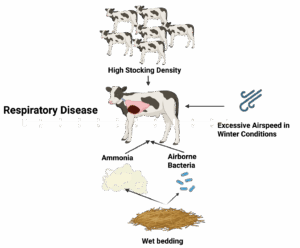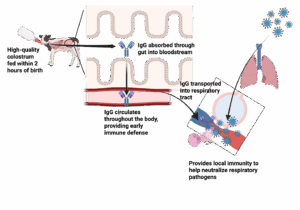はじめに
呼吸器疾患は、離乳前の乳用子牛に影響を及ぼす最も一般的で経済的に重要な健康 問題のひとつです。酪農場における抗生物質治療、獣医学的コスト、子牛の損失のかなりの割合を占め、子牛の健康と生産性を最適な状態に保つための根強い障害となっています。
どのように よくあることですか?
74 の酪農場と 7,800 頭以上の子牛を対象としたカナダの研究では、離乳前の子牛 のうち 30% 近くが、少なくとも 1 回は抗生物質による治療を受けており、治療 の理由として最も多く挙げられていたのは呼吸器疾患でした。具体的には、記録された抗生物質治療のうち、54% を呼吸器疾患が占めていた(Uyama et al.)同様に、2,500 頭以上の子牛を対象とした米国の複数州にわたる研究のデータでは、子牛の 3 分の 1 が少なくとも 1 つの健康イベントを経験しており、病気の子牛のうち 33% に呼吸器系の徴候が見られたと報告されています。呼吸器徴候のあった子牛のうち、88% に抗生物質が投与されました。同じ研究で、離乳前の死亡率は全体で 5% パーセントであり、呼吸器疾患が 14% を占め、さらに 7% が呼吸器系と消化器系の両方の原因で死亡したと報告されている(Urie et al.)
その影響は?
離乳前の時期の呼吸器疾患は、乳牛の成績にも、肉牛や子牛として飼育される子牛の成績にも重大な影響を及ぼす。
最近のメタアナリシスでは、27 件の研究データを用いて、未経産牛の呼吸器疾患 が未経産牛に与える影響を評価しました(Buczinski ら、2021 年)。離乳前の期間に呼吸器疾患と診断された未経産牛は、罹患していない未経産牛 と比較して、初産前に死亡する確率が 3 倍高く、淘汰、売却、死亡のいずれかによって牛群から 除去される確率が 2 倍高くなりました。また、これらの未経産牛は離乳前の段階で1日当たり67グラム体重が減少し、初産泌乳時の乳量が121キログラム減少した。メタアナリシスに含まれる研究では、呼吸器疾患は初産年齢を 8 ~ 14 日遅らせ、初産泌乳期まで生存する可能性を低下させることもわかりました。これらの知見を合わせると、早期の呼吸器疾患が酪農牛群の生産性に与える影響 がよくわかります。
仔牛や乳牛用の子牛の場合も、その影響はかなり大きい。3,519 頭の仔牛を屠畜まで追跡調査した研究では、呼吸器疾患を 1 回発症した子牛は、呼吸器疾患を発症していない子牛と比較して、高温期の枝肉重量が平均 8kg 減少し、脂肪率が低下し、死亡リスクが 6 倍高くなりました(Pardon et al.)呼吸器疾患を 2 回または 3 回以上発症した子牛は、高温枝肉重量がそれぞれ平均 22kg と 42kg 減少した。また、何度も罹患すると、枝肉の品質が低下し、屠畜時の赤身の色が好ましくないものになる可能性が高くなる。
子牛が搾乳牛群向けであろうと、肉牛のサプライチェーン向けであろうと、呼吸器系疾患がもたらす結果は重大であり、子牛の健康と成績を守るためには、的を絞った予防と強固な基礎免疫が重要であることを強調しています。
予防で考慮すべき重要な要素とは?
住宅と環境
子牛が飼育される環境は、子牛の呼吸器の健康に直接的な影響を与えます。適切に管理された飼育環境であれば、病原体への曝露を減らし、免疫機能 をサポートすることができる一方で、劣悪な環境であれば、直接的・間接的なストレ ス要因によって呼吸器疾患のリスクが高まる可能性があります。
敷料は子牛の環境にとって重要な要素です。敷料は糞尿を蓄積し、深く湿ったパックを形成するため、離乳前の子牛の呼吸器疾患の 発生率を高める一因となる(Donlon ら、2023)。これは、細菌負荷の上昇と、汚染された敷料や糞尿中の尿素が微生物によって分解され て生成される汚染物質であるアンモニアの蓄積の両方によるものと考えられる。敷料以外にも、飼育環境の他の側面も一役買っている。適切な換気は湿気や空気中の汚染物質の抑制に役立ちますが、子牛が体温 中立域から外れているときに風速が速すぎると、冷えや呼吸器疾患の増加につながる可能 性があります(Donlon ら、2023)。さらに、子牛 1 頭あたり 35 平方フィートを超えるスペースを確保することで、空気中 の細菌濃度が低下することが示されており、これは空気の流れを改善し、動物の密 度を下げることによるようです(Norlund and Halbach, 2019)。これらの要因の影響については 図1.

図1. 子牛の呼吸器疾患の発症に環境および飼育環境が及ぼす影響。
コロストラムはどこに適合するのか?
コロストラム(初乳)、より具体的には十分な受動免疫の獲得は、呼吸器系疾患の予防につい て議論する際、常に念頭に置かれるわけではありません。しかし、幼若子牛の肺炎リスクを低減する上で、コロストラムが中心的な役割を担っていることは明らかです。
子牛の肺炎に関する 8 件の研究(その多くは酪農牛群を対象としたもの)を最近まと めたところ、初乳の摂取が不十分な子牛は呼吸器疾患にかかる可能性が非常に高い ことがわかりました。特に、受動免疫の移行に失敗した子牛では、呼吸器疾患のリスクが 1.6 倍も高くなりました(Thompson and Smith, 2022)。著者らは、受動免疫の移行に失敗した子牛の呼吸器疾患症例の 31% は、初乳の管理が不十分であったことが直接の原因であると推定しています。つまり、牛群全体では、リスクの高い子牛だけでなく、全ての子牛の受動免疫 を改善することで、肺炎の 6 例に 1 例は回避できたということです。
最近の研究では、これまで考えられていたよりもさらに高いレベルの受動免疫 を獲得することの価値が浮き彫りになっています。10,000 頭の未経産牛を受動免疫レベル別にグループ分けした 3 つの研究(Crannell and Abuelo, 2023; Lombard et al.これらの結果から、優れた受動免疫 (> 血清1Lあたり25gのIgGが吸収される)、単に十分であるだけでなく、初乳の移植は呼吸器疾患の予防に意味のある違いをもたらす。
この保護は、初乳に含まれる主要な抗体である免疫グロブリンGによるものと思われる。IgGは吸収されると血液中を循環し、病原体を中和し、初期の免疫反応をサポートします。全身的な役割に加え、IgGは気道などの粘膜表面にも運ばれ、感染部位で病原体をブロックするのに役立つ。 図2 は、IgGがいかに呼吸器疾患から身を守るかを強調している。コロストラムには、ラクトフェリン、サイトカイン、成長因子のような他の免疫サポート化合物も含まれており、初期の免疫発達と病気に対する回復力をさらに高める。

図2. 初乳が呼吸器疾患の予防をサポートする経路。
メッセージ
子牛の呼吸器疾患を予防するには、環境と初期ケアの両方に気を配る 必要があります。清潔で乾燥した寝具、換気を良くし、十分なスペースを確保することで、空気中の病原体への暴露を減らすことができます。同様に重要なことは、出生後すぐに高品質の初乳を与えることで、子牛が健康を 維持するために必要な保護が得られるということです。これらのことを実践することで、疾病リスクを下げ、治療の必要性を減らし、長期的により良い結果をもたらすことができるのです。
デイブ・ルノーDVM博士、ゲルフ大学准教授
参考文献
Buczinski S, Achard D, Timsit E. 子牛期の呼吸器疾患が乳牛の健康と成績に及ぼす影響:系統的レビューとメタ分析。Journal of Dairy Science.2021 Jul 1;104(7):8214-27.
受動免疫のカテゴリー間での子牛の罹患率、死亡率、将来の成績の比較:酪農牛群におけるレトロスペクティブ・コホート研究。Journal of Dairy Science.2023 Apr 1;106(4):2729-38.
Donlon JD, McAloon CG, Hyde R, Aly S, Pardon B, Mee JF.離乳前の子牛における飼育環境因子と牛呼吸器疾患との関係についての系統的レビュー-第 2 部: 温度、相対湿度、敷料。The Veterinary Journal.2023 Oct 1;300:106032.
Lombard J、Urie N、Garry F、Godden S、Quigley J、Earleywine T、McGuirk S、Moore D、Branan M、Chamorro M、Smith G. 米国における乳用子牛と牛群レベルの受動免疫に関する合意勧告。Journal of dairy science.2020 Aug 1;103(8):7611-24.
Nordlund KV, Halbach CE.健康と管理のしやすさを最適化するための子牛舎の設計。獣医臨床:Food Animal Practice.2019 Mar 1;35(1):29-45.
Pardon B, Hostens M, Duchateau L, Dewulf J, De Bleecker K, Deprez P. 呼吸器疾患、下痢、耳炎、関節炎が白色子牛の死亡率と枝肉形質に及ぼす影響。BMC Veterinary Research.2013 Dec;9:1-4.
Raboisson D, Trillat P, Cahuzac C. 子牛における受動免疫導入の失敗:子牛の受動免疫導入の失敗:その結果と経済的影響の評価に関するメタアナリシス。PloS one.2016 Mar 17;11(3):e0150452.
Sutter F、Venjakob PL、Heuwieser W、Borchardt S. 受動免疫の移行と、出生から離乳までの雌性乳用子牛の健康、成績との関連。Journal of Dairy Science.2023 Oct 1;106(10):7043-55.
Thompson AC, Smith DR.受動免疫の移行不全は、肉牛および乳牛の子牛の離乳前疾患の原因である:系統的レビューとメタ分析。The Bovine Practitioner.2022 Dec 29;56(2):47-61.
Urie NJ, Lombard JE, Shivley CB, Kopral CA, Adams AE, Earleywine TJ, Olson JD, Garry FB.米国の酪農経営における離乳前の未経産牛管理:離乳前の未経産牛の子牛の罹病率と死亡率に関連する要因。Journal of dairy science.2018 Oct 1;101(10):9229-44.
Uyama T, Renaud DL, Morrison EI, McClure JT, LeBlanc SJ, Winder CB, de Jong E, McCubbin KD, Barkema HW, Dufour S, Sanchez J. カナダの乳牛子牛における子牛管理方法と抗菌薬使用の関連性。Journal of Dairy Science.2022 Nov 1;105(11):9084-97.
